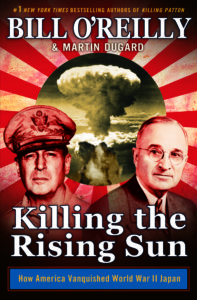Book Review: Killing the Rising Sun by Bill O’Reilly

In a way Bill O’Reilly is a literary version of Donald Trump—a man hell-bent on justifying his intellect by rehashing history while digging only into sources that support his opinions. O’Reilly’s views, on full display in his new work, Killing the Rising Sun: How American Vanquished World War II Japan, show a man who understands his audience far too well to be of any use to anyone else.
At first glance, the title and cover image of the hardcover edition of Killing the Rising Sun (co-written with Martin Dugard) combine to create one of the most undeniably offensive book covers ever. The fact that O’Reilly believed it was okay to put President Harry S. Truman and General Douglas MacArthur’s enlarged heads next to a nuclear explosion shows a sensitivity that is borderline sandbox-age. Surely O’Reilly knew the cover of his book would create a stir, but, as a white, Irish-Scottish American, I couldn’t help but shake my head at the shocking lack of respect shown for an entire nation. Japan has been an ally and friend to the United States since 1945—just because O’Reilly’s core fan base (white, passport-less men of Middle America over the age of fifty-five) isn’t interested in reading a book that humanizes Japan doesn’t mean he has to give them what they want.
If you head over to Amazon and see the reviews, you will find most of them positive and five-starred, written by veterans or sons of veterans who’ve been given the “gift” of seeing the war as America’s badge of honor. These reviews (paid?) will continue, as will the sale of this book for the next decade, simply because this core base of white America enjoys believing that everything America did during World War II, everything that Truman decided, and everything Gen. MacArthur chose was for the “good of the country.” This blissful ignorance is of course a trait that Japan is guilty of as well, but, as an American married to a Japanese woman, I find it more important to focus on the utter lack of human compassion in this book.
So, what, according to Bill O’Reilly, is good for America to remember about the Pacific War?
- In 1975 Emperor Hirohito took a picture at Disneyland and “is said to have been buried wearing a Mickey Mouse watch.” Placing this fact at the end of a war book disturbs me greatly. Vividly, I can imagine that big tough kid in the back of the class reeling off some obscure fact then shrugging, “what…it’s true!”
- “Thousands” of Japanese-Americans were placed in camps. The problem is it wasn’t merely thousands. A more accurate number, discovered with a quick search, is more than 110,000 Japanese-Americans placed in camps. That’s a lot of thousands.
One paragraph after writing that “One millionth of a second later, the people of Hiroshima begin to incinerate,” O’Reilly writes, “All twelve men on board [the Enola Gay] are alive. In six hours they will celebrate with whiskey and lemonade and spend the night far from the hell they have just created.” As writers we have hundreds of choices at our disposal. Mentioning whiskey and lemonade shows a complete lack of empathy.
Of course, O’Reilly would defend himself by noting that in the next section of the book he describes the horrors happening in Hiroshima, and he certainly does with this one line: “Mrs. Aoyama is vaporized.” And this sentence is its own paragraph! Such nuance!
He attempts to rationalize by suggesting she did not suffer: “Death comes so quickly that her nerve endings do not have time to react to pain, nor even acknowledge the presence of the light and heat liquefying her bones and boiling her brain at a temperature five times greater than that of boiling water.”
This bellicose video-game description continues, and it says a great deal that O’Reilly chooses to describe the pain of the victims himself while only sparingly quoting people who were actually there. A large amount of description is devoted to Japanese bodies being “incinerated,” and O’Reilly would argue that by describing the horrific results of the bomb he is in effect making sure that history does not repeat itself. But this is short-sighted. Far better would be to dimensionalize Mrs. Aoyama’s world, go into her mind, her daily routine, spend pages upon pages humanizing her. Then, once you have achieved the feat of understanding Mrs. Aoyama, let’s see if you have the audacity to “vaporize” her.
Of course, devoting pages to depth and description may have risked a slower reading experience, and since O’Reilly is far more worried about making things easy for his reader then providing a measured, balanced perspective of a war in which both sides showed the darkest aspects of the human soul, I’m guessing that was never an option.
Near the end of the book, he O’Reilly tries to tug at the old heartstrings by mentioning that his father, a war veteran, truly believed that if the United States had not dropped those bombs on Hiroshima, “you would very likely not be reading this book.”
I think Mrs. Aoyama would have been okay with that.
